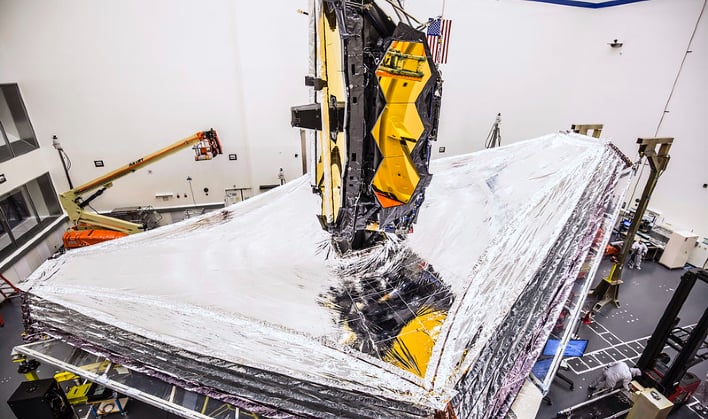NASA’s Webb Space Telescope Opens Its Huge Sunshield Like A Diamond In The Sky

NASA had a very busy and productive year in 2021. Earlier last year, onlookers watched as the Mars Perseverance Rover made its harrowing landing on the surface of the red planet. Just months later, the Ingenuity Helicopter that rode on the belly of Perseverance made its first flight. In late November, the Double Asteroid Redirection test (DART) launched and began its long journey to slam into asteroid Dimorphos in order to prepare for a potential doomsday event. In mid-December, the Parker Solar Probe became the first human-made spacecraft to touch the sun. And most recently, teams that have been working on the James Webb Space Telescope for two and a half decades were finally able to watch as it launched into space on Christmas day. NASA finished off 2021 with a critical milestone for JWST as the spacecraft's sunshield took on its diamond form.
Shine bright like a diamond 💎
— NASA Webb Telescope (@NASAWebb) January 1, 2022
With the successful deployment of our right sunshield mid-boom, or “arm,” Webb’s sunshield has now taken on its diamond shape in space. Next up: tensioning the 5 sunshield layers! https://t.co/6G2caS1djY #UnfoldTheUniverse pic.twitter.com/q0iuHdnKlN
Keith Parrish, Webb observatory manager at NASA's Goddard Space Flight Center, stated, "The mid-booms are the sunshield's workhorse and do the heavy lifting to unfold and pull the membranes into that now-iconic shape."
It was imperative that the sunshield take its shape and position, because without it the mission would have not been able to proceed. JWST will primarily use infrared light from faint and extremely distant objects in order to produce the pictures that astronomers and scientists are hoping for. In order for this to be possible, the telescope itself must be kept very cold to protect it from external sources of light and heat such as the Sun, Earth, and Moon. The sunshield, which is about the size of a tennis court, will act as a canopy providing shade.
As JWST travels, the sunshield will always be between the Sun/Earth/Moon and the telescope. Positioning will be made possible because JWST will be orbiting the Sun some 1.5 million kilometers away from the Earth. The sunshield will keep the telescope at a temperature below 50 Kelvin (-370 degrees Fahrenheit, or -233 degrees Celsius) by passively radiating its heat into space. This is the reason the sunshield has five layers. Each layer will block some of the heat, and then deflect the rest out the sides. The process will keep very little heat from ever reaching the telescope and its instrumentation.
The five layers are made of a material called Kapton. All five layers are then coated with aluminum, and the sun-facing side of the two hottest layers also having a "doped silicone" coating to reflect the Sun's heat back into space. Kapton is a polyimide film that was created by DuPont in the late 1960's. The material has a high heat-resistance and is able to remain stable across a wide range of temperatures. Even at the highest of temperatures, the material will not burn or melt. These properties are also why it is used in a variety of electrical and electronic insulation applications.
The shape, number of layers and distance between those layers are also important. Each of the five layers are precisely positioned and separated to accomplish their function. James Cooper, JWST Sunshield Manager at NASA's Goddard Space Flight Center in Maryland, explained, "The shape and design also direct heat out the sides, around the perimeter, between the layers. Heat generated by the Spacecraft bus at the 'core,' or center, is forced out between the membrane layers so that it cannot heat up the objects."
Completion of the rolling out of the sunshield did come with a slight delay. The operations team decided to take some caution and not hurry the process. Parrish said, "Today is an example of why we continue to say that we don't think our deployment schedule might change, but that we expect it to change. The team did what we had rehearsed for this kind of situation--stop, assess, and move forward methodically with a plan. We still have a long way to go with this whole deployment process."
As the observatory continues to undergo its transformation into its final form, teams at NASA will continue to meet each milestone with caution and bated breath. They understand the extreme importance for each and every single mechanism to operate as it should in order for the mission to be successful. As the old saying goes, it is better to be safe than sorry. And with all that is riding on the full realization of JWST, patience and careful planning will be required every step of the way.

